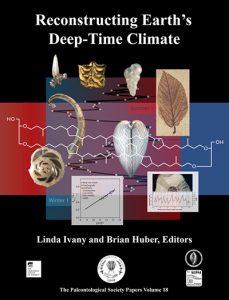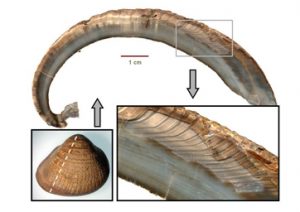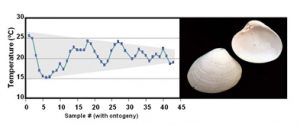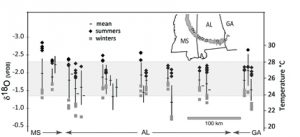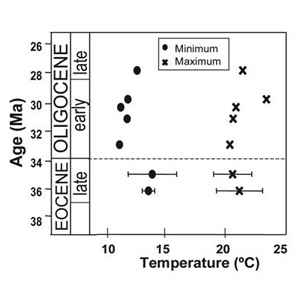Stable Isotopes and Accretionary Skeletons: Paleoseasonality
Accretionary biogenic carbonates, such as the shells of fossil mollusks, offer an opportunity to recover information about seasonality in Earth’s deep past. High-resolution sampling and isotope analysis along the growth history of an organism can yield a detailed a record of the temperatures experienced by an individual throughout some portion of its lifetime. Capturing a number of years within a particular stratigraphic horizon yields not only a robust measure of seasonal temperature range for that habitat, but also information about inter-annual variability. With adequate coverage, both of these variables can be examined in a temporal or geographic context to see how they relate to change in mean annual temperature. The approach is not without its challenges – sampling resolution can smear the seasonal signal, organisms do not necessarily accrete carbonate throughout the year, and the depth at which benthic aquatic organisms live correlates roughly with the seasonal range they experience. Nevertheless, with a bit of care, these kinds of data can offer new insights on the climate system and the anticipated consequences of global change.
Student Research
- Andrew Beard (M.Sc.) “Regional variation in seasonal oxygen isotope values of Permian bivalves from Southeastern Australia”
- Ellen De Man (Ph.D.) “Foraminifer biofacies and stable isotope analyses as paleoproxies for Oligocene environments, southern North Sea Basin” (Co-supervisor with Noel Vandenberghe, University of Leuven, Belgium)
- Caitlin Keating-Bitonti (B.S.) “How warm was the early Eocene? Paleotemperature reconstructions for the US Gulf Coast from the shells of Venericardia (Bivalvia)”
- Nicole Miklus (M.Sc.) “The high-latitude response of temperature seasonality to global Eocene cooling”
- Devin Buick (B.S.) “100 years in the dark: extreme longevity of Eocene bivalves from Antarctica”
- Christina Hartman (M.Sc.) “High Resolution Stable Isotope Paleoclimatology of the Jurassic Great Estuarine Group”
- Daren McGregor (MS Student) “Late Cretaceous latitudinal gradients in temperature and seasonality using the marine oyster Exogyra cancellata”
Publications
(*student author; †postdoc author)
Ivany, L. C., and Huber, B. T., Editors, 2012, Reconstructing Earth’s Deep-Time Climate, volume 18, The Paleontological Society Papers, 262 p.
Ivany, L.C. (2012) Reconstructing paleoseasonality from accretionary skeletal carbonates: challenges and opportunities. In L. C. Ivany, and B. T. Huber (Editors), Reconstructing Earth’s Deep-Time Climate. Paleontological Society Papers, v. 18, pp. 133-165. Download table of Download table of contents. Download chapter.
Sessa†, J.A., Ivany, L.C., Schlossnagle*, T., Samson, S.D., and Schellenberg, S.A. (2012) The fidelity of oxygen and strontium isotope values from shallow shelf settings: implications for temperature and age reconstructions. Palaeogeography, Palaeoclimatology, Palaeoecology v. 342-343, pp. 27-39.
Ivany, L.C., Brey, T., Huber, M., Buick, D.P., and Schöne, B.R. (2011) El Niño in the Eocene greenhouse recorded by fossil bivalves and wood from Antarctica. Geophysical Research Letters. v. 38, L16709, doi:10.1029/2011GL048635.
Keating-Bitonti*, C.R., Ivany, L.C., Affek, H.P., Douglas, P., Samson, S.D. (2011) Warm, not super-hot, temperatures in the early Eocene subtropics. Geology v. 39, pp. 771-774.
Ivany, L.C. and Runnegar, B. (2010) Early Permian seasonality from bivalve δ18O and implications for the oxygen isotopic composition of seawater. Geology v. 38, pp. 1027-1030.
Kobashi, Takuro, Grossman, Ethan L., Dockery, David T., and Ivany, Linda C. (2004) Watermass stability reconstructions from greenhouse (Eocene) to icehouse (Oligocene) for the northern Gulf Coast continental shelf (U.S.A.). Paleoceanography, v. 19, PA 1022, doi: 10.1029/2003PA000934 (16 pages).
Ivany, Linda C., Wilkinson, Bruce W., Lohmann, Kyger C, Johnson, Emily R., McElroy, Brandon J., and Cohen, Gregory J.* (2004) Intra-annual isotopic variation in Venericardia bivalves: Implications for early Eocene climate, seasonality, and salinity on the US Gulf Coast. Journal of Sedimentary Research, 74, pp. 7-19.
Buick, Devin P.* and Ivany, Linda C. (2004) 100 years in the dark: extreme longevity of Eocene bivalves from Antarctica. Geology, v. 32, pp. 921-924.
Ivany, Linda C., Lohmann, Kyger C, and Patterson, William P. (2003) Paleogene temperature history of the US Gulf Coastal Plain inferred from fossil otoliths. In Prothero, D., Ivany, L.C., and Nesbitt, E. (eds) From Greenhouse to Icehouse:The Marine Eocene-Oligocene Transition. New York: Columbia University Press, pp. 232-251.
Wilkinson, Bruce H. and Ivany, Linda C. (2002) Paleoclimatic inference from stable isotopic compositions of accretionary biogenic hardparts – a quantitative approach to the evaluation of incomplete data. Palaeogeography, Palaeoclimatology, Palaeoecology, 185, pp. 95-114.
Ivany, Linda C., Patterson, William P., and Lohmann, Kyger C (2000) Cooler winters as a possible cause of mass extinctions at the Eocene-Oligocene boundary. Nature, 407, pp. 887-890.

